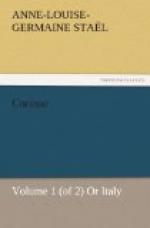Oswald and Corinne, having seen the Capitoline Hill the day before, began their walks by Mount Palatine; it was entirely occupied by the palace of the Caesars, called the golden palace. This hill offers nothing to our view, at present, but the ruins of that palace. The four sides of it were built by Augustus Tiberius, Caligula, and Nero; but the stones, covered with fertile plants, are all that now remain of it: Nature has there resumed her empire over the labours of man, and the beauty of the flowers consoles us for the destruction of the palace. The luxury of the times of the kings and of the Republic only consisted in public edifices; private houses were very small, and very simple. Cicero, Hortensius, and the Gracchi, dwelt upon Mount Palatine, which, at the decline of Rome, was scarcely sufficient for the abode of a single man. In the latter ages, the nation was nothing more than an anonymous crowd, merely designated by the era of its master. We look in vain here for the two laurels planted before the door of Augustus, the laurel of war, and that of the fine arts cultivated by peace; both have disappeared.
There is still remaining, on Mount Palatine, some chambers of the Baths of Livia; we are there shown the holes which contained the precious stones that were then lavished upon ceilings, as a common ornament, and paintings are to be seen there whose colours are yet perfectly untouched; the fragility of the colours adds to our astonishment at seeing them preserved, and seems to carry us back nearer to past ages. If it be true that Livia shortened the days of Augustus, it is in one of these rooms that the crime was conceived, and the eyes of the sovereign of the world, betrayed in his most intimate affections, were perhaps fixed upon one of those pictures whose elegant flowers still remain[16]. What, in old age, were his thoughts upon his life and his pomp? Did he recall to mind his proscriptions or his glory? Did he hope, or did he fear a world to come? Does the last thought, which reveals everything to man; does the last thought of a master of the universe still wander beneath these vaults?
Mount Aventine offers more traces than any other of the first periods of the Roman History. Exactly opposite the Palace, raised by Tiberius, we see the ruins of the Temple of Liberty, which was built by the father of the Gracchi. At the foot of Mount Aventine stood the temple dedicated to the Fortune of men by Servius Tullius, to thank the gods for having raised him from the condition of a slave to the rank of a king. Without the walls of Rome we find also the ruins of a temple, which was consecrated to the Fortune of women when Veturia stopped the progress of Coriolanus. Opposite Mount Aventine is Mount Janicula, on which Porsenna placed his army. It was opposite this Mount that Horatius Cocles caused the bridge leading to Rome to be cut away behind him. The foundation of this bridge is still to be seen;




